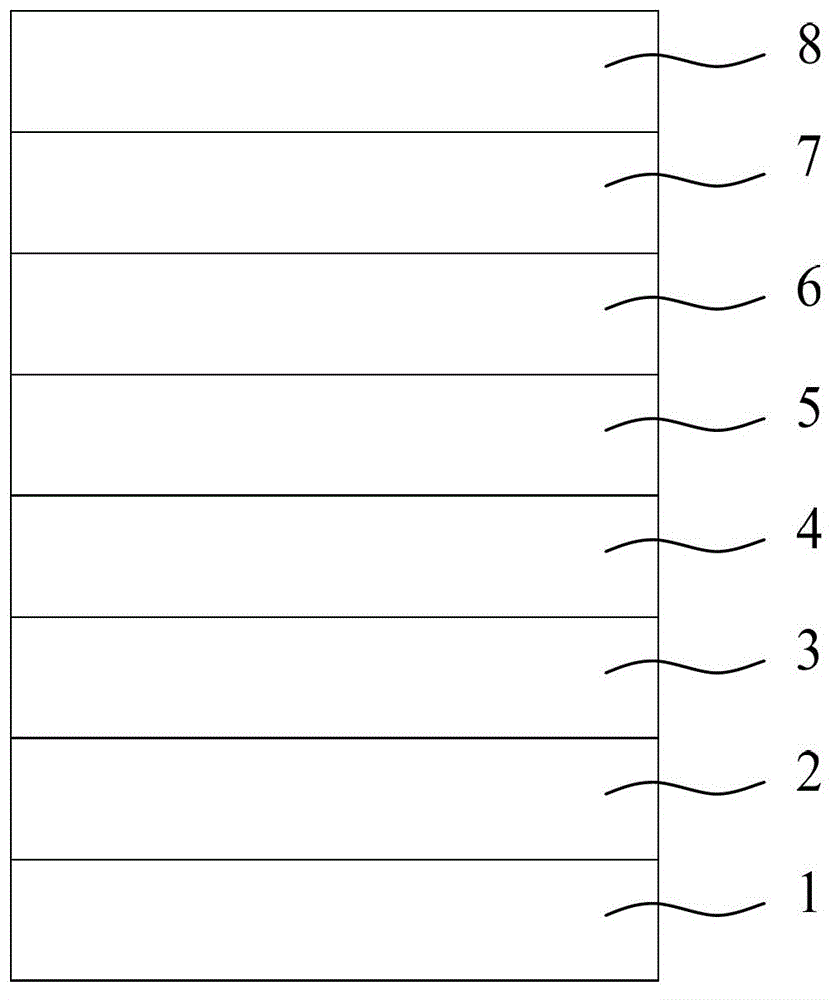Organic electroluminescent device and preparation method
An electroluminescence device and electroluminescence technology, which are applied in the manufacturing of organic semiconductor devices, electric solid state devices, semiconductor/solid state devices, etc., can solve the problems of low light output performance, refractive index difference, light loss, etc. Improve stability and improve the effect of light scattering
- Summary
- Abstract
- Description
- Claims
- Application Information
AI Technical Summary
Problems solved by technology
Method used
Image
Examples
Embodiment 1
[0041] A method for preparing an organic electroluminescent device, comprising the following steps:
[0042] (1) After rinsing the glass with distilled water and ethanol, soak it in isopropanol overnight. Prepare the anode 2 by vapor deposition on the glass substrate 1, the material of the anode 2 is Ag, the thickness is 10nm, and the vapor deposition pressure is 8×10 -4 Pa, the evaporation rate is 2nm / s.
[0043] (2) The hole injection layer 3 is prepared on the anode 2 by electron beam evaporation, and the material of the hole injection layer is SiO 2 with PrO 2 A mixed material formed at a mass ratio of 0.15:1 (expressed as PrO 2 :SiO2 2 ), the thickness of the hole injection layer is 10nm, and the energy density of electron beam evaporation is 30W / cm 2 .
[0044] (3) Hole transport layer 4, light-emitting layer 5, electron transport layer 6, electron injection layer 7 and cathode 8 are sequentially evaporated on the hole injection layer to obtain an organic electrolu...
Embodiment 2
[0053] A method for preparing an organic electroluminescent device, comprising the following steps:
[0054] (1) After rinsing the glass with distilled water and ethanol, soak it in isopropanol overnight. Prepare the anode by evaporation on the glass substrate, the anode material is Al, the thickness is 5nm, and the evaporation pressure is 2×10 -3 Pa, the evaporation rate is 10nm / s.
[0055] (2) The hole injection layer is prepared by electron beam evaporation on the anode, and the material of the hole injection layer is SiO 2 with Pr 2 o 3 A mixed material formed at a mass ratio of 0.5:1 (expressed as Pr 2 o 3 :SiO2 2 ), the thickness of the hole injection layer is 5nm, and the energy density of electron beam evaporation is 10W / cm 2 .
[0056] (3) On the hole injection layer, the hole transport layer, the light emitting layer, the electron transport layer, the electron injection layer and the cathode are sequentially evaporated to obtain an organic electroluminescence...
Embodiment 3
[0065] A method for preparing an organic electroluminescent device, comprising the following steps:
[0066] (1) After rinsing the glass with distilled water and ethanol, soak it in isopropanol overnight. Prepare the anode by evaporation on the glass substrate, the anode material is Au, the thickness is 30nm, and the evaporation pressure is 5×10 -5 Pa, the evaporation rate is 1nm / s.
[0067] (2) The hole injection layer is prepared by electron beam evaporation on the anode, and the material of the hole injection layer is SiO and Yb 2 o 3 A mixed material formed at a mass ratio of 0.1:1 (expressed as Yb 2 o 3 :SiO), the thickness of the hole injection layer is 5nm, and the energy density of electron beam evaporation is 100W / cm 2 .
[0068] (3) On the hole injection layer, the hole transport layer, the light emitting layer, the electron transport layer, the electron injection layer and the cathode are sequentially evaporated to obtain an organic electroluminescence device,...
PUM
 Login to View More
Login to View More Abstract
Description
Claims
Application Information
 Login to View More
Login to View More - R&D
- Intellectual Property
- Life Sciences
- Materials
- Tech Scout
- Unparalleled Data Quality
- Higher Quality Content
- 60% Fewer Hallucinations
Browse by: Latest US Patents, China's latest patents, Technical Efficacy Thesaurus, Application Domain, Technology Topic, Popular Technical Reports.
© 2025 PatSnap. All rights reserved.Legal|Privacy policy|Modern Slavery Act Transparency Statement|Sitemap|About US| Contact US: help@patsnap.com


